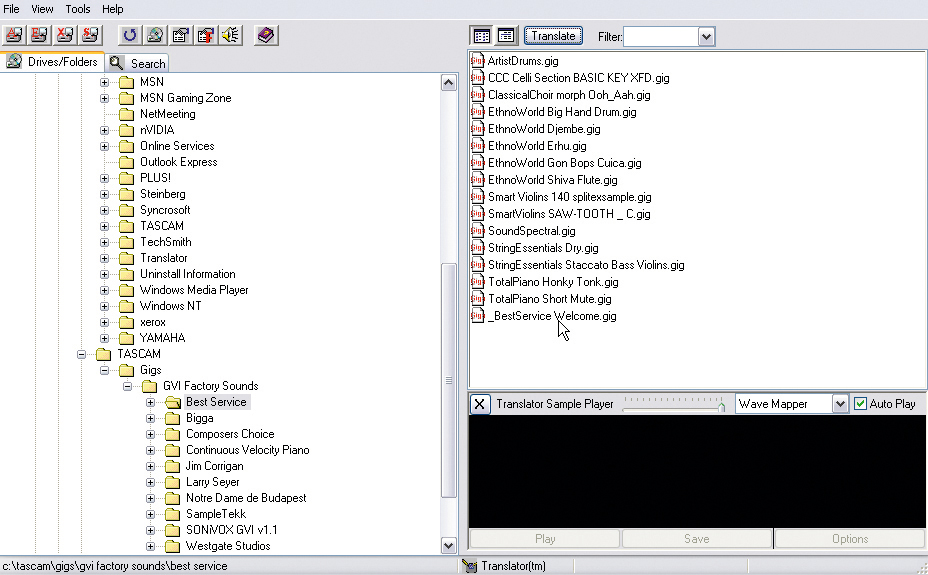MusicRadar Verdict
If you simply want high-quality instruments in your sequencer, GVI is worth considering. However, there are more flexible samplers available.
Pros
- +
Great bundled sounds. Strong third-party support. Integrates nicely with your host. Standalone version also included.
Cons
- -
A few stability issues. Minimum CPU requirements are steep. Too little too late?
MusicRadar's got your back


Over 7GB of samples are on offer.

Synthesis tools aren't in short supply.
Until now, GigaStudio has always been restricted to standalone usage, which isn´t a total surprise; this program can put some serious hurt on your CPU, as a Giga instrument can be multisampled six ways to Sunday. All sorts of intricate performance controllers are available to ensure that every bow squeak, buzzy fret and other real world variation is represented. In fact, so power hungry is GigaStudio that many users dedicate entire computers -- or even multiple networked computers -- to running it.
The good news is that, as we all know, computers are now much faster than they were. This being the case, Tascam have launched a version of GigaStudio that plugs into your DAW. This version goes by the name of Giga Virtual Instrument (GVI). Essentially a simplified, playback version of the standalone program, it runs as a VST or RTAS plug-in in any compatible host.
Installation is easy, though with over 7GB of samples to copy to your drive, you´re going to be tied up for a while. It's possible to be a bit put off by the high number of demo sounds featured. Thankfully, there´s a higher ratio of fully realised instruments in GVI. In fact, there are only a few demo patches, and though they have fewer samples than the full versions, they´re still pretty playable. In fact, the bulk of the library is superb. The supplied instruments come from some of the best sample providers in the business, including Larry Seyer, Bigga and Best Service. Sonivox (formerly Sonic Implants) have provided the most comprehensive collection of patches -- this covers both rock and orchestral instruments and even a bit of ethnic percussion.
GVIvories
Even back when it was called GigaSampler, Tascam´s software has always featured a beefy set of piano samples. This remains the case today: you get a fully modelled piano that makes use of Tascam´s GigaPulse modelling processor to add some space and microphone character. Such technology demands its pound of flesh, though, and it´s all too easy to ratchet up the CPU meter when you´re using an instrument such as this one. Tascam offers some condolences in the form of a GVI version of said piano that eats around half the power, with very little realism sacrificed.
Most people who buy GVI will probably use it as a playback tool for prefab sounds. However, should you decide that you´d like to tweak your instruments, the software comes with a full arsenal of synthesis tools spread across four pages. The familiar Mixer page is where sounds are loaded up, panned and mixed to taste, and from here, you can access a General page that enables you to adjust velocity response and the like. The Filter page offers filter envelopes and a multimode resonant filter with a dedicated LFO. Further manipulation is possible in the Amplitude/Pitch section. Again, there are LFO and both amp and pitch envelopes. Finally, you can define loop points in the Loop editor.
Functional design
Want all the hottest music and gear news, reviews, deals, features and more, direct to your inbox? Sign up here.
Giga products have been around for a while, and this much is evident when you use GVI. It´s functionally designed, easy to get around and potentially very powerful. After all, some of the very best sample content on the planet is designed specifically to take advantage of Giga´s unique functions. As a plug-in, GVI performs well, though there can be some minor instability when running it in Sonar 6. The software can be run standalone too, though without all of the bells and whistles of GigaStudio 3.
In truth, this illustrates GVI´s biggest problem: it suffers in comparison to its big brother and other plug-in samplers. For deep sample-mangling options and lots of onboard effects, you´d be better off with Kontakt 2, and if you want to record files and create your own Giga instruments, you´ll need a full-on version of GigaStudio. Despite its limitations, though, GVI is far from a disaster. In fact, if all you require is access to the vast library of third-party Giga instruments from within your DAW, it´d fit the bill nicely.
MusicRadar is the number 1 website for music makers of all kinds, be they guitarists, drummers, keyboard players, djs or producers...
GEAR: We help musicians find the best gear with top-ranking gear round-ups and high- quality, authoritative reviews by a wide team of highly experienced experts.
TIPS: We also provide tuition, from bite-sized tips to advanced work-outs and guidance from recognised musicians and stars.
STARS: We talk to musicians and stars about their creative processes, and the nuts and bolts of their gear and technique. We give fans an insight into the actual craft of music making that no other music website can.
